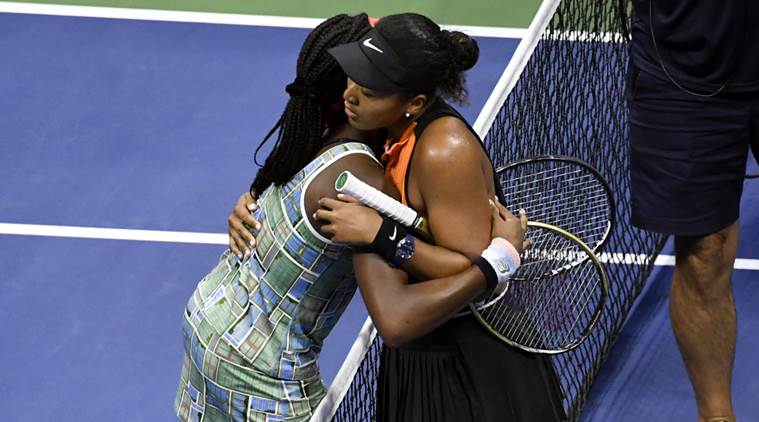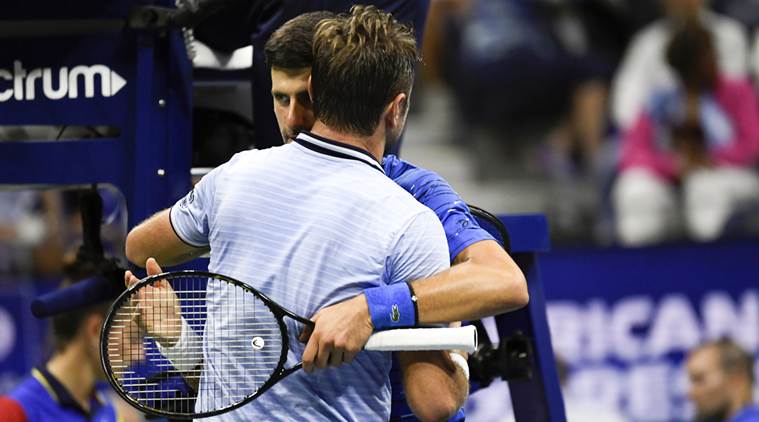
By Cindy Shmerler
Not that long ago, Naomi Osaka was struggling to adapt to the shifting tradition in tennis of using hugs instead handshakes as the gesture of grace at the end of a match.
“I’m told that I give out the worst hugs,” Osaka said last year, after winning the U.S. Open at 20 years old.
“The thing is, I’m used to handshakes,” she added. “Every time someone comes for a hug, I’m very confused.”
By Saturday night, after the third match of her title defense, Osaka had more than perfected her take on the new brand of sportsmanship.
She not only hugged a tearful Coco Gauff, the 15-year-old sensation she had just knocked out of the Open — but she took Gauff completely under her wing. Osaka consoled the younger player, encouraging her to address the crowd in an on-court interview that typically belongs to the winner and assuring her that it would be better to keep crying openly in front of the fans than to retreat inconsolably to the showers.
❤️🎾@Naomi_Osaka_ | @CocoGauff#USOpen pic.twitter.com/ouVQenQki6
— US Open Tennis (@usopen) September 1, 2019
The scene was extraordinary but hardly unique for a 21st-century Grand Slam tournament. When Novak Djokovic, playing with a sore shoulder at the Open, retired midmatch against Stan Wawrinka on Sunday night, the two draped their arms around each other’s necks.
And there was a moment of affection last year that became an instant meme. After Djokovic beat Juan Martín del Potro to win the Open, they skipped the traditional postmatch handshake.
Instead, Djokovic and del Potro embraced for several seconds, as if they were long-lost brothers seeing each other for the first time in years. The image was replayed on screens throughout the world.
“I think it’s because we both love each other,” said del Potro, who missed this year’s U.S. Open with a knee injury. “We have a great relationship, and we always play the great battles. The people love when the two players are fighting until the last point. A huge hug means a lot to the crowd and to us as well.”
There was a time when the end of a tennis match required nothing more than a firm handshake and maybe a few kind words before both players gathered their belongings and left the court. The same held true for men and women.
Today, hugging has become the new handshake, providing a level of intimacy that may make postmatch meetings at the net as unrecognizable to past players as innovations like the Hawk-Eye ball tracking system and serving time limits.
“We never hugged,” said Pam Shriver, who played throughout the 1980s against

Chris Evert and Martina Navratilova.
“The closest I came was when I beat Martina, who was my friend and doubles partner, in 1982,” Shriver continued. “I only beat her three times out of 42. It was a huge upset. We still shook hands, but we put an arm around each other as we walked to the umpire’s chair. It was such a big deal that the picture ran, above the fold, in the next day’s New York Times.”
In 1980, Bjorn Borg sank to his knees after outlasting John McEnroe in a classic fourth-set tiebreaker in the Wimbledon final. After he arose, Borg did little more than approach the net with his head down and share a limp handshake with McEnroe before walking off.
In an awkward moment after Pete Sampras beat Andre Agassi in a five-set semifinal at the 2000 Australian Open, the two looked as if they were actually going to hug. But their arms got jumbled, and they ended up settling for a traditional handshake.
Eighteen years later at the Australian Open, when Caroline Wozniacki beat Simona Halep to win her first major, their prolonged embrace looked more like two camp friends saying goodbye at the end of the summer than two top-flight athletes after a fierce battle. Same when Sloane Stephens defeated her close friend Madison Keys to win the 2017 U.S. Open. As they waited for the trophy presentation, Stephens and Keys sat side by side, laughing.
So why has on-court hugging become a thing? Has everyone on tour suddenly become BFFs?
“You’re not going to do it with everyone,” said Kevin Anderson, the 2017 runner-up at the U.S. Open. “But most guys know that we’re out there working as hard as we can. We’re all competitors, but we’re also friends.”
For Djokovic, hugging has become part of his mental routine, the result of time with Pepe Imaz, a Spanish spiritual guru who specialized in a technique with meditation and prolonged hugs called Amor y Paz (“Love and Peace”).
Allen Fox, a California-based sports psychologist who has counseled athletes for more than 40 years, said hugs are now “part and parcel of every athletic competition, no matter the sport.”
“Back in the day, athletes were trying to be classy, so they kept their emotions in check, shook hands at the end of a match and left the court,” he said. “Men, in particular, were taught to be strong, not to share their personal struggles and to be quiet about their issues. They were trained not to be sappy out there, to take a loss with a stiff upper lip.
“Now people think nothing of hugging and crying after their matches.”
Even when postmatch hugs aren’t warranted or wanted, most players now opt for a modified “bro-shake” — a bring-it-in handshake that turns into a one-armed hug. It is often accompanied by chest pats or back pats, especially among the men.
“I really think these handshakes become hugs when you have matches that are long, physically and emotionally draining,” said Michael Chang, the 1989 French Open champion. “Seeing them embrace is really a sign from both players that says, ‘If we could have two winners, that would be my choice.’ ”
Chang said his generation learned from the generations before: “Can you imagine McEnroe, [Jimmy] Connors and [Ivan] Lendl ever hugging each other?”
Now, though, an embrace doesn’t bother Lendl, who has coached Andy Murray and Alexander Zverev.
“Personally, I view it as a sign of mutual respect between opponents in a big battle on the court,” Lendl said.
Some players on the WTA and ATP tours aren’t close friends, and that is reflected in their behavior. Others cling to the older standards.
Serena Williams relied on the new custom to get through one of the toughest moments of her career — the immediate aftermath of her loss to Osaka in last year’s U.S. Open final. Osaka’s victory was overshadowed by clashes between Williams and the chair umpire, who penalized Williams a point and then a game, infuriating the crowd.
Seeing Osaka approach the net on the verge of tears with her head down, Williams pivoted quickly from her frustration, flashed a sweet smile and threw her arms around the young champion.
A year later, Osaka took similar care of Gauff.
“Psychologists have taught their athletes: You’re a better person for wearing your heart of your sleeve,” Fox, the psychologist, said. “That’s supposed to improve your self-esteem. Giving someone a hug at the end of the match doesn’t make the loss less painful, but at that moment, it might make both players feel a little better.”